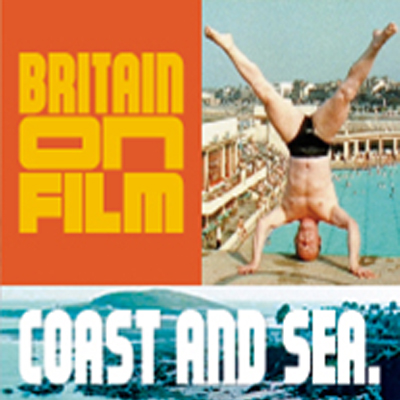Britain on Film: Coast and Sea

Date Posted: June 15, 2017
Last year Britain on Film took a closer look at rural life across the UK. Now the BFI has launched Britain on Film: Coast and Sea, an online collection of over 600 newly digitised films, ranging from 1898 to 2000, from the BFI National Archive and the UK’s national and regional film and TV archives, with content spanning the whole of the UK, available (mostly) for free on BFI Player via an interactive map. Coast and Sea highlights in Northern Ireland include homesick university lecturers morris dancing, the strange world of local filmmakers the Spence Brothers, and a spiritual maritime adventure from the shores of Derry to Iona captured by two films which haven’t been seen in decades.
Since Britain on Film’s launch, over 30 million people have accessed their country’s film heritage through BFI Player and social media channels. With this new collection over 7,500 films can now be seen online – 97% of which are free. By 2018, thanks to National Lottery funding and the support of the Esmée Fairbairn Foundation, 10,000 film and TV titles from 1895 to the present day will be newly digitised and available to view.
Coast and Sea charts our changing relationship with the land and the sea and the intrinsic connection with our national self-image. Using the Britain on Film map, with the click of a mouse viewers can plot their own course, circumnavigating over 11,000 miles of varied coastline through film, from the southernmost tip of the Scilly Isles to the northernmost reaches of the Shetland Islands, to search and explore locations which hold a deeply personal connection, or collective concerns which occupy us a whole; leisure, industry, environmentalism, the weather.
Robin Baker, Head Curator, BFI National Archive said, “Britain on Film has been a transformative project for the BFI and our partner archives. It has demonstrated that millions of people across the UK want to engage with their film heritage. Comprising over a century of filmmaking, Britain on Film has highlighted some of the lesser-known films from our collections, some of which not even curators had seen before, and provided them with audiences that are often bigger than on their first release. There are over 600 newly added films, contextualised by curators, exploring lives led and holidays enjoyed around the UK coast. As such there are now even greater opportunities for people to while away hours watching and making discoveries about British film heritage.”
Britain on Film curators have again found extraordinary footage of ordinary people and places, to shed a fascinating insight into our shared cultural and social history on film. This treasure trove of rarely seen archive footage reveals the truly eclectic pastimes along Northern Ireland’s coastline over the last 60 years.
Morris Dancers at Portrush, filmed in 1977, discovers Northern Ireland’s only Morris Dancing Group, formed in 1971 from the University of Ulster in Coleraine. They began performing as a support act for the Chieftains, before going on to dance across Ireland, France and England.
Watch elephants cross the Foyle Bridge in The Circus Comes to Town (1960), and Lammas Fair, 1964 captures many of the traditional facets of the festival, be it the multitude of stallholders selling their goods, or the general air of celebration conjured by musicians, dancers and people playing games.
In Bonamargy Ghost, these UTV news rushes tell tales of Julia McQuillan, a mysterious prophet and a recluse who chose to live alone among the ruins of Bonamargy after the Friary fell out of use in the 17th century. Some believe that Julia was murdered on the steps leading to the upper floor of the Friary, others say she fell off the thirteenth step and bad luck will befall anyone who sets one’s foot there.
Boating on the Bann (1960) takes a journey along the Bann, the longest river in Northern Ireland; Beauty to Last celebrates the National Trust’s spectacular coastal properties with panoramic views of the Northern Ireland coastline and Mussenden Temple sitting on its cliff edge; and join the Logan family to reminisce and you might find their holiday in Portrush leads to Many Happy Returns (1956).
Saint Columba – 1963, filmed by the then Northern Ireland Tourist Board, reveals through colourful pageants the man who despite being a dove by name was plagued with a violent temper. And In Curragh to Iona, this spiritual quest, funded by the Church of Ireland to commemorate the 14th centenary of St. Columba’s journey of self-exile, took four years to prepare. The narrator Wallace Clark was an insatiable seafarer and talented skipper who motivated this fearless crew to brave the 100 mile journey in a simple canvas covered boat.
John de Vere, 2nd Baron Wakehurst, was Governor of Northern Ireland from 1952-1964. Throughout his life he was a prolific filmmaker who used his privileged access to capture historic moments in glorious colour. Ulster Richer and Rarer (1960) probes Ulster’s byways where you can experience the disappearing tradition of seaweed harvesting.
Twin brothers from Comber, Roy and Noel Spence have been making films for over fifty years, two of which paint vivid pictures of different aspects of coastal life.
Greenisland Rock (1982) gives an enjoyable glimpse into a family reviving the Teddy boy culture in 1980’s Northern Ireland, while Maidens in Distress (1976) is a charming documentary about the East Maiden lighthouse. Meet the men who bring essential supplies to the lighthouse keepers and join this merry crew on the little Island Magee ferry for an enjoyable day out. This film was made just one year before East Maiden became automated and the need for this essential service disappeared.
Northern Ireland’s coastal heritage has also provided fresh inspiration for local artists. Poets Ross Thompson and Olive Broderick were commissioned to respond to archive content in the creation of new works. Their spoken word contributions have been set alongside edited archive films by TACA and new soundtrack compositions by Dáithí McGibbon.
There is also an exciting nationwide programme in partnership with the BFI Film Audience Network (FAN) offering audiences ways to discover, explore and engage with the coast and sea relating to local stories in their own area. Northern Ireland Screen’s Digital Film Archive has programmed a mix of screenings, exhibitions and performances along the Northern Ireland coastline celebrating our coastal and maritime heritage, including a new commission by local musician Malojian and filmmaker Colm Laverty, who have curated a collection of coastal-themed archive film for Malojian’s new video single, Some New Bones.
Northern Ireland Screen’s Digital Film Archive will be supporting a number of film screenings run by the Belfast Film Festival, Newcastle Cinema Club and Strand Arts Centre. A full list of screenings is available on the Northern Ireland Screen website. Staff from Digital Film Archive will also be present at Auld Lammas Fair, Red Sails and Airwaves festivals screening footage from the archive and giving talks on Northern Ireland’s celluloid history.
Francis Jones, Archive Education officer, Northern Ireland Screen Digital film Archive said, “Britain on Film is a fantastic celebration of the UK’s history on film. Northern Ireland Screen’s Digital Film Archive is delighted to be taking part again this year following on from the success of last year’s Rural programme. This year’s theme of Coastal and Sea is a perfect fit to Northern Ireland’s maritime and costal heritage. We are excited by the programme of events we have been able to put together with our partners and look forward to showing the public glimpses of Northern Ireland’s history.”
To start enjoying Coast and Sea footage, log on to player.bfi.org.uk/britain-on-film



